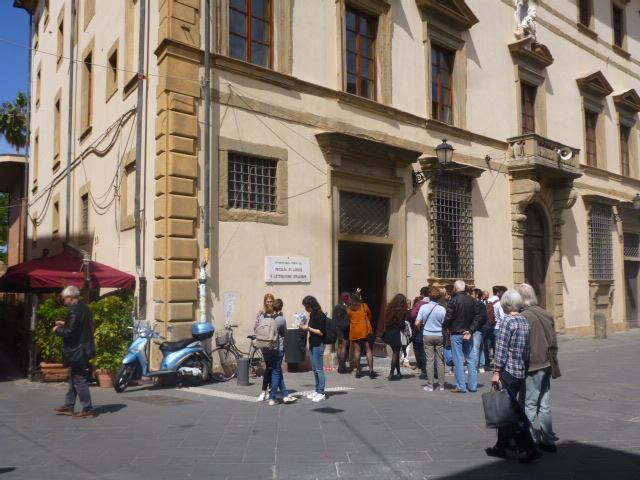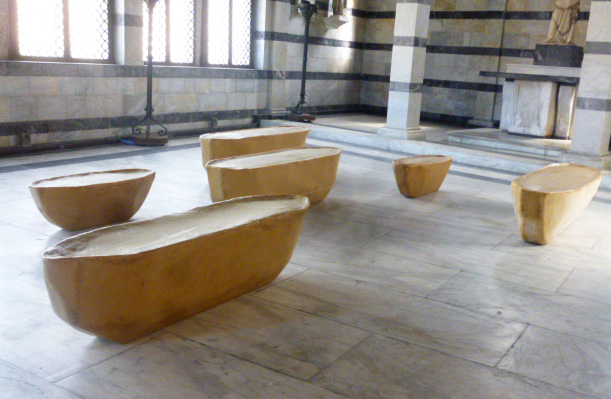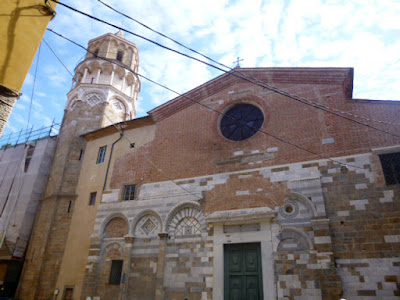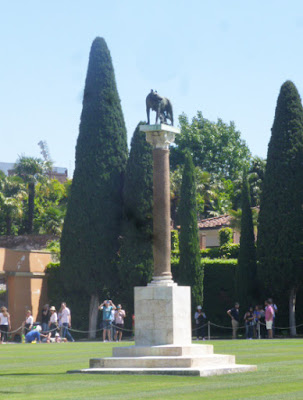Mei 11 : Pisa

Door de poort onder de oude versterkingen tot aan de Arno gewandeld (langs de Pza S Paolo)
 |
| Chiesa San Paolo (in restauratie) |

Wolfgang Laib’s "You will go somewhere else" evokes the idea of a spacious setting, a kind of ‘spiritual precinct.’ It consists of a fleet of ships made of beeswax on a wood scaffolding. The artist’s working process demonstrates a kind of purity and calm concentration, reflected likewise in the simplicity of his materials. Laib’s formal vocabulary, which tends towards abstraction, is based on geometrical figures and forms such as the rectangle, circle, pyramid, cone, and the stylized, archetypal motifs of house, mountain, boat or stairs. The form of the beeswax boats – inaccessible conveyances into another world – extends a spiritual invitation for us to strive, in reflection and contemplation, towards unknown goals.


 |
Statua di Ferdinando de' Medici, piazza Carrara |

 |
| De buurt van de Universiteiten. Via Maria |
 |
| Chiesa San Frediano |

 |
Museo nazionale della Certosa monumentale di CalciLa Certosa di Pisa a Calci è un vasto complesso monumentale che sorge alle pendici del Monte Pisano, a pochi chilometri dalla città di Pisa. Fondato nel 1366 da una famiglia di certosini, il complesso è stato ampliato tra il XVII e il XVIII secolo e si presenta oggi come uno splendido monumento barocco inserito in un contesto paesaggistico fortemente suggestivo. Originariamente detta “buia”, la valle di Calci fu rinominata Val Graziosa (piena di grazia) proprio in seguito alla fondazione del complesso monastico. Nel 1972 la Certosa, abbandonata dai pochi monaci rimasti, divenne Museo Nazionale, mentre nel 1979 la parte occidentale del complesso fu concessa in uso perpetuo e gratuito all’Università di Pisa, che vi fondò il Museo di Storia Naturale, da allora ampliato, arricchito e rinnovato. Oggi la Certosa ospita quindi due distinti musei: il Museo Nazionale della Certosa Monumentale di Calci e il Museo di Storia Naturale dell’Università di Pisa. Le due istituzioni museali sono nate in tempi diversi, appartengono a enti pubblici distinti, sono collocate in parti differenti del complesso e hanno due diversi profili tematici e didattici. Tuttavia le loro vicende e collezioni, apparentemente così diverse, si intrecciano indissolubilmente all’affascinante storia del grande edificio che le custodisce. |

Palazzo dell’Arcivescovado, The Archbishop’s Palace
From the early 10th century, the area became the headquarters of the Bishops court; the Church of S. Giorgio ad Curte Piscopi, later incorporated into in the south-eastern corner of the building stood here. Documents recount that in 1178 the Domus Episcopi was already sufficiently spacious and elegant to receive Federico Barbarossa, but it was not until the time of Archbisop Saltarelli in the 14th century that the building assumed an imposing appearance, before further enlargement and changes in mid 15th century.
The Archives of the Arcidiocese of Pisa are kept in the Archbishop’s palace.

De Dom, beter bekend als de Duomo di Santa Maria Assunta, is gewijd aan Maria en vormt het centrale hart van dit wereldberoemde plein. De kathedraal heeft de vorm van een vijfbeukige basiliek met een driebeukig transept
De bouw van de Duomo di Santa Maria Assunta begon in 1064 onder de architect Buscheto die de Dom liet bouwen in een typisch Pisaanse romaanse stijl waarbij het gebruik van verschillende kleuren marmer, dwerggalerijen en blinde bogen in de onderste zones bijzondere kenmerken zijn.




Het Battistero (doopkapel) is gewijd aan Johannes de Doper en is een van de hoogtepunten van de stad Pisa. Het is de grootste doopkapel van Italie en biedt met zijn bijna 55 meter een prachtig uitzicht op de Duomo.
De Doopkapel van Pisa is gebouwd tussen 1152 en 1363 en is een prachtige mix van romaanse en gotische architectuur, waarbij elke verdieping in een andere stijl is gebouwd.De bouw van het ronde gebouw startte in de twaalfde eeuw door de architect Diotisalvi. Hij gebruikte hiervoor de romaanse stijl. De constructie werd echter niet afgemaakt tot de veertiende eeuw toen de loggia, de bovenverdieping en de koepel werd toegevoegd.
De architecten Nicola Pisano en Giovanni Pisano zetten de bouw verder in een gotische stij













































































Reacties
Een reactie posten